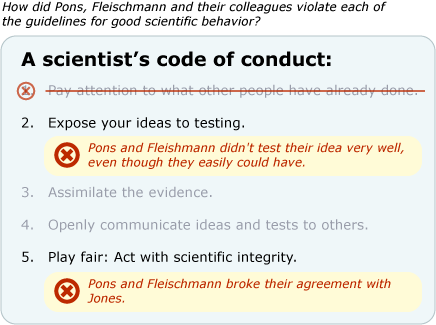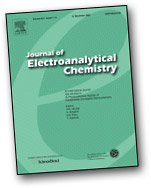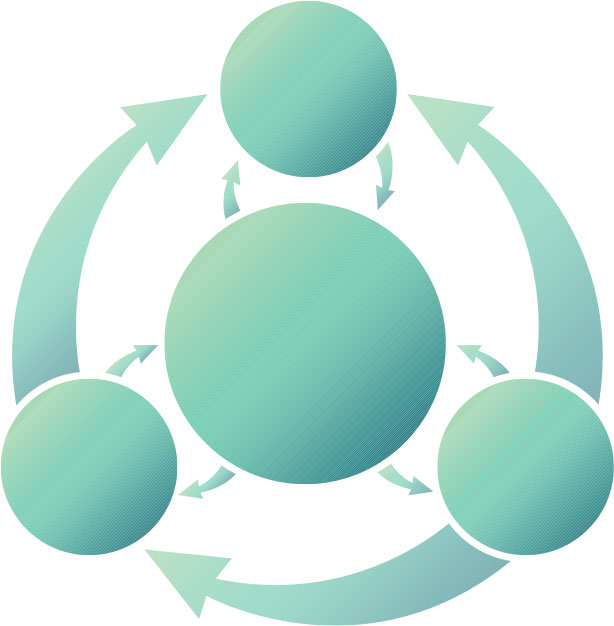Though they’d just agreed to a joint submission in 18 days and despite the fact that they’d originally wanted 18 months to complete their experiments, Pons and Fleischmann jumped ahead of Jones and submitted a journal article on their own just five days later. This action broke with standards for scientific behavior on two levels. First, they failed to uphold the ethical standards set by the scientific community by breaking the intent (if not the letter) of their agreement with Jones. Second, they didn’t sufficiently expose their ideas to testing. In their rush to publish, they failed to perform some simple and obvious experiments, the results of which would have provided key evidence about whether or not their cold fusion hypothesis was correct. For example, they could have:
- Run their fusion cell with regular water in place of the deuterium-rich heavy water. In science, this is known as a control. If the experiment generated excess heat — even when it lacked the key ingredient, deuterium — it would be strong evidence against the idea that fusion was the cause of the heat.
- Used another metal in place of palladium. Their hypothesis relied on the large amount of deuterium that palladium could absorb. If another metal with less absorption capacity could produce similar results, then this would also be strong evidence against fusion. This is another example of a control.
- Used a more advanced heat measurement technique. Pons and Fleischmann used a technique in which gasses were allowed to escape the fusion cell and then the amount of heat carried away by these gasses was estimated. If they had used a different technique in which no gasses escaped, they would have obtained more accurate results.
- Sought expert advice on their search for neutrons and other nuclear products. Detecting these particles is not easy, and Pons had no previous experience in this area. On top of that, the equipment Pons used was not very sensitive. More sensitive equipment and more experience operating it would have added credibility to their claims.

 Pons and Fleischmann submitted their paper to the Journal of Electroanalytical Chemistry, whose editor felt that the weight of Pons and Fleischmann’s potential discovery merited special treatment. The editor put the article through an abbreviated form of peer review — the system science has in place to make sure journal articles meet good scientific standards. Peer review can catch a variety of shortcomings in articles before they get published. For instance, peer reviewers normally notice when the evidence is insufficient to support the authors’ claims (as was the case for Pons and Fleischmann’s) and suggest that additional evidence be collected before publication. Reviewers also look for potential flaws in reasoning and experimental design. Adequate peer review might have caught a serious flaw in Pons and Fleischmann’s logic — they had incorrectly calculated the magnitudes of the forces acting on deuterium while inside palladium. The correct calculation revealed forces much, much smaller — too small to push deuterium atoms close enough together to fuse. However, this and other shortcomings in Pons and Fleischmann’s article slipped through the rushed review. The reviewers had just one week to scrutinize the paper (when several weeks are usually allowed) and didn’t get to review the changes the authors made in the second draft.1 This short review period bypassed some of the checks set up in the process of science, and would eventually contribute to unnecessary confusion, as well as wasted time, energy and money.
Pons and Fleischmann submitted their paper to the Journal of Electroanalytical Chemistry, whose editor felt that the weight of Pons and Fleischmann’s potential discovery merited special treatment. The editor put the article through an abbreviated form of peer review — the system science has in place to make sure journal articles meet good scientific standards. Peer review can catch a variety of shortcomings in articles before they get published. For instance, peer reviewers normally notice when the evidence is insufficient to support the authors’ claims (as was the case for Pons and Fleischmann’s) and suggest that additional evidence be collected before publication. Reviewers also look for potential flaws in reasoning and experimental design. Adequate peer review might have caught a serious flaw in Pons and Fleischmann’s logic — they had incorrectly calculated the magnitudes of the forces acting on deuterium while inside palladium. The correct calculation revealed forces much, much smaller — too small to push deuterium atoms close enough together to fuse. However, this and other shortcomings in Pons and Fleischmann’s article slipped through the rushed review. The reviewers had just one week to scrutinize the paper (when several weeks are usually allowed) and didn’t get to review the changes the authors made in the second draft.1 This short review period bypassed some of the checks set up in the process of science, and would eventually contribute to unnecessary confusion, as well as wasted time, energy and money.
It’s not entirely clear why Pons and Fleischmann chose to publish so much earlier than they had initially intended, but the impact on their study is apparent. Many scientists later criticized their lack of thoroughness as well as the quality of their work. Pons and Fleischmann had not performed the experiments or the analysis very carefully, and a month after the paper appeared, they had to publish a list of corrections two pages long that included important modifications to their data. However, before the scientific community got their chance to evaluate Pons and Fleischmann’s ideas about cold fusion, the two brought their claims to the public at large.
To learn more about journal articles and peer review visit What’s in a scientific journal article? and Scrutinizing science: Peer review.
1Whether the paper was ever sent out to reviewers at all is not clear. See "Cold Fusion: the Scientific Fiasco of the Century," by John Huizenga, p.19, and "Bad Science," by Gary Taubes, p.162, for differing accounts.
